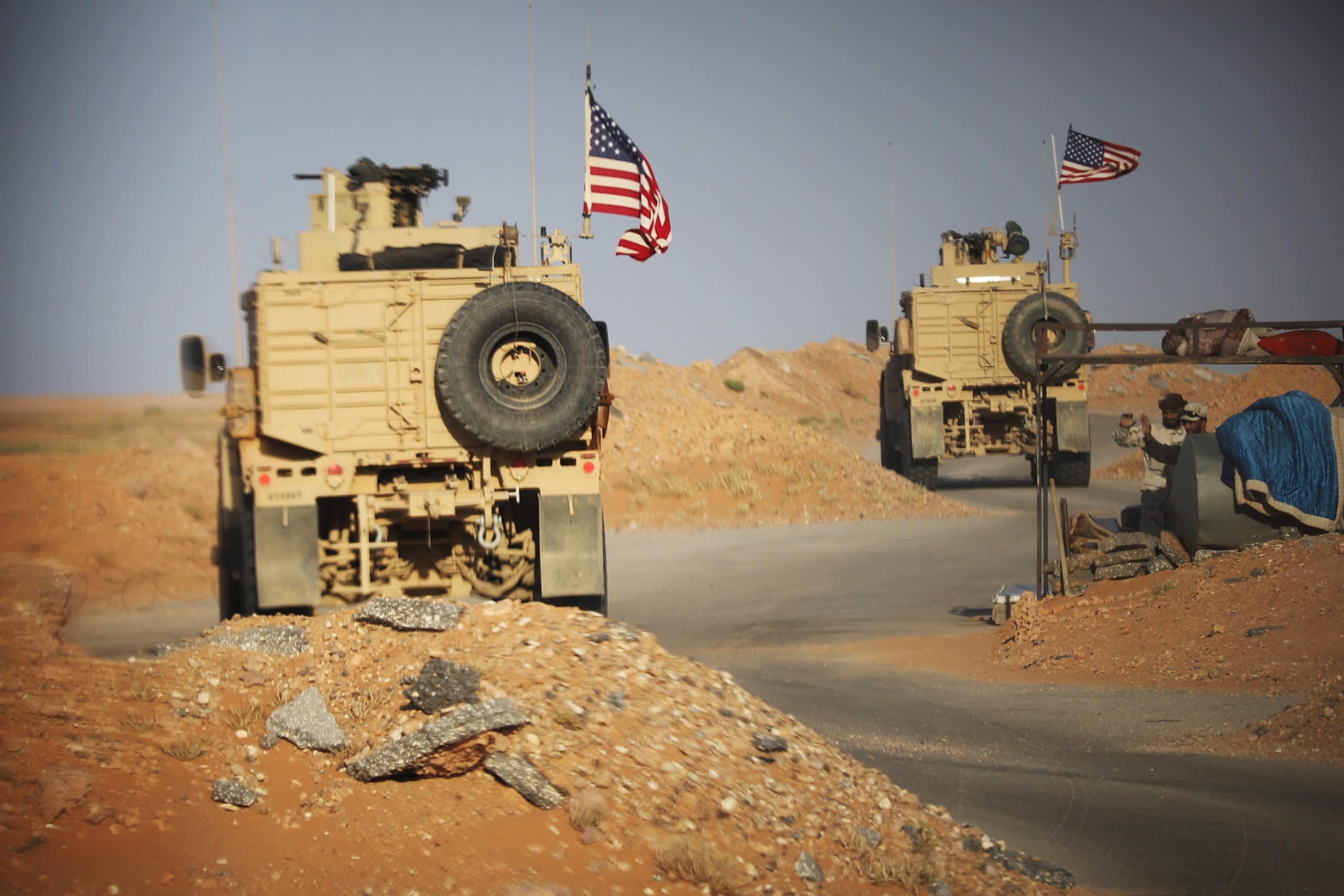December 15, 2020 | Defending Forward Monograph
America’s Small but Effective Presence in Syria
December 15, 2020 | Defending Forward Monograph
America’s Small but Effective Presence in Syria
American debates about the U.S. military presence in Syria highlight sharp differences within the Trump administration and within both political parties. In each of these political quarters, there are those determined to disengage from the Middle East and those who insist the United States still has vital interests in the region.1
An eagerness to end America’s costly engagements in the Middle East is not difficult to understand. Yet U.S. policy toward Syria ought to reflect a clear-eyed assessment of the country’s relevance to U.S. interests, not merely frustrations related to the conflicts in Iraq and Afghanistan. Admittedly, there are painful lessons to learn from those wars. But what advocates of withdrawal from Syria fail to recognize is that the U.S.-led campaign against the Islamic State in Syria and Iraq was successful because it drew upon those lessons.
The grinding difficulty of maintaining tens of thousands of troops in Iraq led the Pentagon to recognize that the sustainability of multi-year counterterrorist operations depends on the replacement of direct U.S. military efforts with an indirect approach that works “by, with, and through” local partner forces.2 The current operation in Syria has demonstrated the potency of that approach. A contingent of U.S. troops, numbering roughly 2,000 at its peak, has since supported the SDF, whose numbers (including auxiliaries) the Pentagon Inspector General estimated at 100,000.3 The SDF suffered more than 11,000 deaths on the battlefield fighting the Islamic State.4 If not for the SDF, many of the dead would have been Americans.
While the United States and its partners defeated the caliphate, a low-level insurgency continues.5 Moreover, a principal lesson of the U.S. intervention in Iraq is that victories won on the battlefield will prove fleeting if not followed by stability operations. American troops and their SDF partners hold significant terrain in Syria, supporting U.S. efforts to counter the Islamic State but also the Islamic Republic of Iran’s patient campaign to dominate the region.
A withdrawal from Syria would compromise American efforts to contain both the Sunni and Shiite varieties of violent Islamist extremism. Defeating these adversaries will require decades, not years. The U.S. involvement in Syria may remain necessary until the SDF can deal with the Islamic State and other threats on its own. But this involvement should not require the commitment of large numbers of forces if Washington employs an indirect approach. Indeed, U.S. operations in Syria have demonstrated that long-term efforts are sustainable, requiring the commitment of modest military assets deployed in a largely supporting role.
The ability of the Islamic State to inspire and launch mass-casualty attacks in the United States and Europe ensured broad bipartisan and transatlantic support for combat operations in Iraq and Syria beginning in 2014.6 From that point onward, the U.S.-led anti-ISIS coalition pursued a consistent objective of defeating the caliphate, and that focus endured even amidst the transfer of power between two very different U.S. administrations. Both administrations understood that the United States has a vital interest in preventing the resurgence of either the Islamic State or a successor group determined to carry out terrorist attacks abroad.
America’s continued presence in Syria directly impacts U.S. policy relating to the Islamic Republic of Iran, since Tehran considers the regime of Bashar al-Assad to be an indispensable client. While fighting ISIS, the U.S.-led coalition secured terrain in northeast Syria that comprised roughly 30 percent of the country’s land area, including key oil and gas fields. The American presence now hinders Iran’s “land bridge” (a ground transport corridor) across Syria and Iraq connecting Iran to areas under the control of Lebanese Hezbollah – a key component of Iran’s plans to wage war on Israel.7
Northeast Syria also includes a lengthy border with Turkey. Turkey has been at war for decades with the Kurdistan Workers’ Party, which is both a U.S.-designated Foreign Terrorist Organization and the progenitor of the Kurdish People’s Protection Units (YPG).8 Since the YPG forms an integral part of the U.S.-aligned SDF, the U.S.-led campaign has amplified tensions between Washington and Ankara.
The Pentagon provides little public information about the number or disposition of troops in Syria. The department indicated in April 2018 it would no longer report the aggregate number of troops in Syria.9 Media reports indicated the presence of roughly 1,000 U.S. troops in Syria when President Trump issued his second withdrawal order in October 2019. This was the second time Trump announced a full withdrawal from Syria only to amend his decision following vigorous objections from his advisors and congressional Republicans.10 Then-Secretary of Defense Mark Esper told reporters the following month, “We’re going to have about 500 to 600-ish troops there, at the end of the day.” He said this number did not include the garrison at al-Tanf, which sits astride the main highway running from Baghdad to Damascus near the convergence of the Syrian, Iraqi, and Jordanian borders. This garrison houses no more than 200 U.S. troops.11
Open-source data indicate that in addition to its presence at al-Tanf, the United States maintains bases near the Rumeilan oil field in the northeastern tip of Syria, as well as bases near three other oil fields further south along the Euphrates River in Deir Ezzor province.12 This is consistent with the president’s emphasis on ensuring Syrian energy resources stay out of enemy hands. The al-Tanf garrison also enables the United States and its local partners to disrupt ISIS operations in Syria’s southeastern desert.13
In Syria, the risks of withdrawal are not hypothetical. This became abundantly clear in October 2019, when Trump ordered the sudden pullback of forces from the Syrian-Turkish border. In response, Turkish strongman Recep Tayyip Erdogan immediately sent troops and proxy forces across the border to attack Kurdish elements of the SDF. Turkish forces also committed atrocities and displaced large numbers of civilians.14 Pressure on ISIS diminished, as Kurdish SDF fighters pivoted to counter Turkey’s advance.15 And Russia exploited the chaos by inserting its own troops into the area, including those involved in a September 2020 vehicle collision with U.S. forces.16
The greatest loss caused by Trump’s withdrawal order may have been the SDF’s diminished trust in the United States. Tens of thousands of SDF fighters had conducted ground operations as part of the coalition, which has allowed the United States to fight mainly from the air and minimize its casualties. Having a partner like the SDF is the reason the United States has been able to employ an indirect approach, in keeping with the painful lessons learned in Iraq and Afghanistan.
Assuming America can rebuild trust with its partners on the ground, reliance on an indirect approach should be the way forward for the American military in Syria. This would allay concerns about the cost of long-term deployments, in terms of both lives and funding. The Pentagon does not report the annual cost of operations in Syria, but we know that operational forces account for a small portion of the warfighting budget.17
Fewer than a thousand U.S. troops now operate in Syria in an area twice the size of Massachusetts, where they train and advise a partner force that numbers in the tens of thousands. That U.S. number should be regularly reviewed. Indeed, if the goal is to prevent a resurgence of the Islamic State, halt Iran’s ambitions, or prevent other malign actors from expanding their reach, the Pentagon may need additional forces.

U.S. forces drive through a partner-force checkpoint after a successful joint patrol mission near al-Tanf Garrison, Syria,
on April 29, 2020. (Photo via U.S. Army Staff Sergeant William Howard)
Of course, in keeping with their authorized mission, U.S. forces within Syria do not conduct operations against Assad’s forces or their Russian and Iranian partners, except in self-defense.18 Still, the presence of U.S. forces in tandem with the SDF helps to advance a range of American interests. And it does so at minimal cost.
The views expressed or implied in this commentary are solely those of the authors and do not necessarily represent the views of the U.S. Army, the Department of Defense, or any other U.S. government agency.
